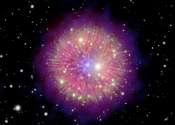Researchers consider whether supernovae killed off large ocean animals at dawn of Pleistocene
About 2.6 million years ago, an oddly bright light arrived in the prehistoric sky and lingered there for weeks or months. It was a supernova some 150 light years away from Earth. Within a few hundred years, long after the ...








